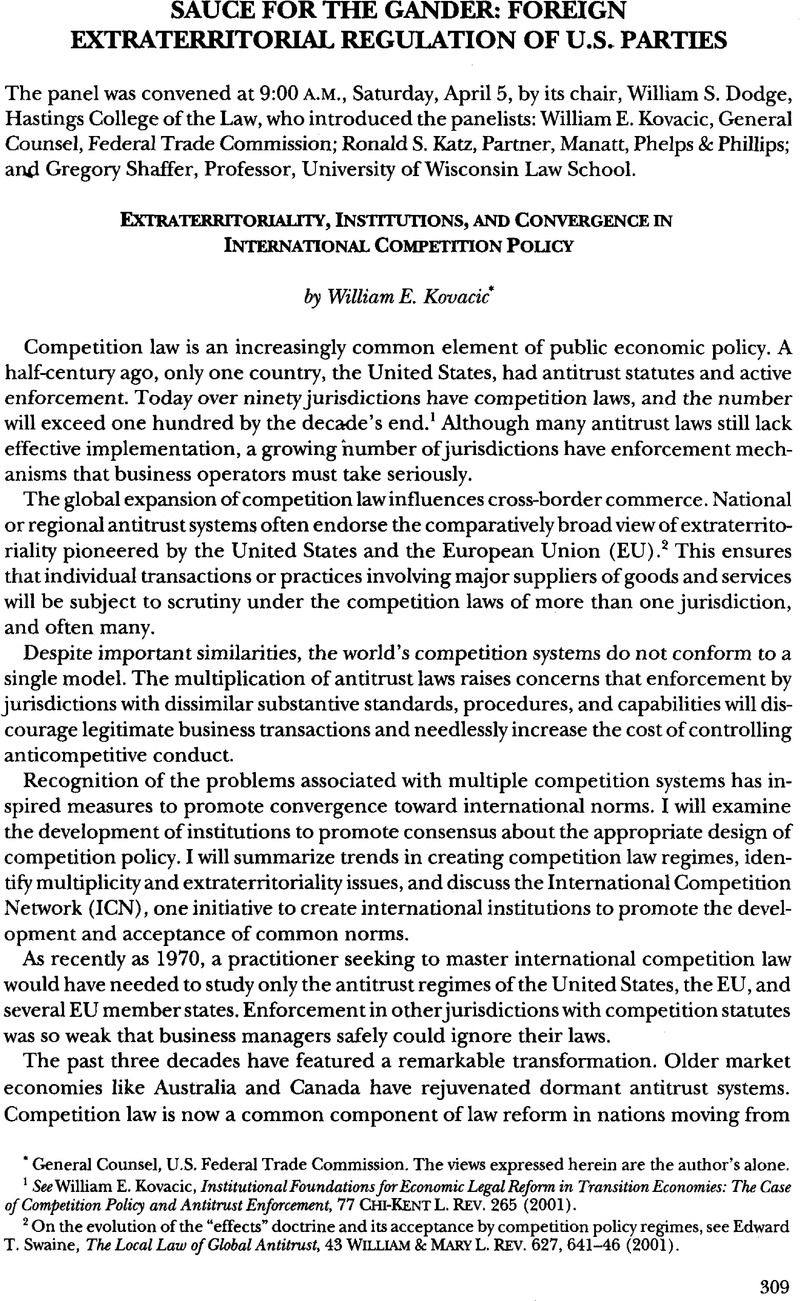Article contents
Extraterritoriality, Institutions, and Convergence in International Competition Policy
Published online by Cambridge University Press: 28 February 2017
Abstract

- Type
- Sauce for the Gander: Foreign Extraterritorial Regulation of U.S. Parties
- Information
- Copyright
- Copyright © American Society of International Law 2003
References
1 See Kovacic, William E., Institutional Foundations for Economic Legal Reform in Transition Economies: The Case of Competition Policy and Antitrust Enforcement, 77 Chi-Kent L. Rev. 265 (2001)Google Scholar.
2 On the evolution of the “effects” doctrine and its acceptance by competition policy regimes, see Swaine, Edward T., The Local Law of Global Antitrust, 43 William & Maryl. Rev. 627, 641-46 (2001)Google Scholar.
3 See Kovacic, William E., Getting Started: Creating New Competition Policy Institutions in Transition Economies, 23 Brook. J. Int’l L. 403, 403-08 (1997)Google Scholar (describing competition policy systems as element of law reform in transition economies).
4 On the Boeing/McDonnell Douglas merger, see Kovacic, William E., Transatlantic Turbulence: The Boeing-McDonnell Douglas Merger and International Competition Policy, 68 Antitrust L.J. 805 (2001)Google Scholar. On General Electric/Honeywell, see Timothy J. Muris, Merger Enforcement in a World of Multiple Arbiters, remarks berbre the Brookings Institution Roundtable on Trade & Investment, Washington, DC (Dec. 21, 2001), available at <http://www.ftc.gov/speeches/muris/brookings/pdf>.
5 The private right of action in U.S. antitrust law is described in Andrew I. Gavil et al., Antitrust Law in Perspective: Cases, Concepts and Problems in Competition Policy 923-26 (2002).
6 Notable examples include United Phosphorus, Ltd. v. Angus Chem. Co., 322 F.3d 942 (7th Cir. 2003) (en banc); Empagran S.A. v. F. Hoffman-Laroche, Ltd., 315 F.3d 338 (D.C. Cir. 2003); Kruman v. Christie’s Int’l Plc, 284 F.3d 384 (2d Cir. 2002); Den Norské Stats Oljeselskap As v. HeereMac Vof, 241 F.3d 420 (5th Cir. 2001), cert, denied, 534 U.S. 1127 (2002).
7 15 U.S.C. §6a.
8 With regard to the cases cited supra in footnote 6, defendants successfully invoked the Ftaia to bar the plaintiffs claims in HeereMac and United Phosphorus. Plaintiffs prevailed on the Ftaia question in Empagran and Kruman.
9 In deciding whether to use leniency measures to reduce the punishment imposed by any single competition authority, a cartel member assesses the exposure it will incur from other government authorities and other litigants (e.g., private claimants in the United States). Estimating damages potentially owed to foreign claimants suing in U.S. courts might be so uncertain that the firm declines to seek leniency, and the cartel’s detection is delayed. On the use of leniency to detect cartels, see Spratling, Gary R., Detection and Deterrence: Rewarding Informants for Reporting Violations, 69 Geo. Wash. L. Rev. 798 (2001)Google Scholar.
10 See Kovacic, Institutional Foundations, supra note 1, at 301-10 (describing common weaknesses in transition economies in institutions necessary to implement competition laws).
11 This discussion uses the model of convergence presented in Muris, Timodiy J., Competition Agencies in a Market-Based Global Economy, Remarks at the Annual Lecture of die European Foreign Affairs Review (July 23, 2002)CrossRefGoogle Scholar, available at <http://www.ftc.gov/speeches/muris/020723/brussels>.
12 The concept of competition policy “R&D” is introduced in Muris, Timothy J., Looking Forward: The Federal Trade Commission and the Future Development of U.S. Competition Policy, Remarks for the Milton Handler Annual Antitrust Review (Dec. 10, 2002)Google Scholar, available at <http://www.ftc.gov/speeches/muris/handler>.
- 7
- Cited by


